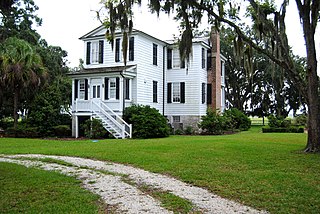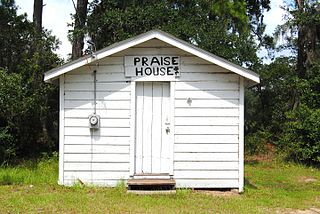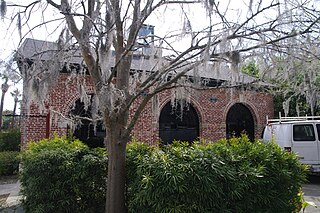
Beaufort is a city in and the county seat of Beaufort County, South Carolina, United States. Chartered in 1711, it is the second-oldest city in South Carolina, behind Charleston. The city's population was 12,361 in the 2010 census. It is a primary city within the Hilton Head Island-Bluffton-Beaufort, SC Metropolitan Statistical Area.

Port Royal is a town on Port Royal Island in Beaufort County, South Carolina, United States. Largely because of annexation of surrounding areas, the population of Port Royal rose from 3,950 in 2000 to 10,678 in 2010, a 170% increase. As defined by the U.S. Census Bureau, Port Royal is included within the Hilton Head Island-Bluffton-Beaufort, SC Metropolitan Statistical Area. Port Royal is home to Marine Corps Recruit Depot Parris Island and Naval Hospital Beaufort.

Marine Corps Recruit Depot Parris Island is an 8,095-acre (32.76 km2) military installation located within Port Royal, South Carolina, approximately 5 miles (8.0 km) south of Beaufort, the community that is typically associated with the installation. MCRD Parris Island is used for United States Marine Corps Recruit Training of enlisted United States Marines. Recruits living east of the Mississippi River report there to receive initial training. Recruits living west of the Mississippi River receive training at Marine Corps Recruit Depot San Diego, California, but may train at MCRD Parris Island by special request.

Beaufort National Cemetery is a United States National Cemetery located in Beaufort County, in the city of Beaufort, South Carolina. Managed by the United States Department of Veterans Affairs, it encompasses 33.1 acres (13.4 ha), and as of 2014, had over 19,000 interments.
The Camp Saxton Site is a 6-acre (24,000 m2) property located in Port Royal, South Carolina. It was listed in the National Register Historic Places on February 2, 1995.

Isaac Fripp House Ruins is a historic house ruin and archaeological site located on Saint Helena Island near Frogmore, Beaufort County, South Carolina. The ruins are located at Bay View overlooking the junction of Chowan Creek and the Beaufort River. The two-story, tabby house dates to the early- to mid-19th century. It is associated with Isaac Fripp, a planter of sea island cotton and other staples on St. Helena Island.

Riverside Plantation Tabby Ruins is a historic archeological site located on Saint Helena Island near Frogmore, Beaufort County, South Carolina. The ruins are significant as an example of early- to mid-19th century tabby construction. The ruins are the remains of an outbuilding associated with the Riverside Plantation and have great archaeological potential.

The Oaks, also known as the Cooler House, is a historic plantation house located on Saint Helena Island near Frogmore, Beaufort County, South Carolina. It was built about 1855, and is a two-story, vernacular frame I-House. Edward L. Pierce chose The Oaks as his headquarters during the military occupation of St. Helena during the American Civil War. The Oaks was the center for military and agricultural activities on the island. On June 18, 1862, Ellen Murray, who had ten days earlier arrived from Pennsylvania, opened the Penn School for Freedmen in a back room of the house. The house also served as a hotel for military personnel from Port Royal, superintendents, and teachers.
Lands End Road Tabby Ruins is a historic archeological site located on Saint Helena Island near Frogmore, Beaufort County, South Carolina. The site contains the archaeological remains of a large late-18th to early-19th century house. The site has a tabby foundation pier and the partial outlines of a structure.

Little Barnwell Island is a historic archeological site located near Port Royal, Beaufort County, South Carolina. The site consists of two shell and earth mounds located on the eastern side of Little Barnwell Island overlooking Whale Branch. The larger of the two mounds is elliptical and once served as the base for a temple or ceremonial building. The mounds and building were probably constructed during the late Savannah II Period ca. A.D. 1500.

Tombee Plantation is a historic plantation house located on Saint Helena Island near Frogmore, Beaufort County, South Carolina. It was built about 1790–1800, and is two-story, T-shaped frame dwelling. It is sheathed in clapboard and has a gable roof. It features a single-story front portico with four square columns and a two-story balustraded rear porch with six square columns on each floor. Along with Seaside Plantation, it is one of the few surviving antebellum plantation houses remaining on St. Helena Island. The Tombee Plantation property was divided into tracts during the days of the "Port Royal Experiment" in 1862. It remained in the hands of descendants of freed slaves until 1971.

Seaside Plantation, also known as the Edgar Fripp Plantation, is a historic plantation house located on Saint Helena Island near Beaufort, Beaufort County, South Carolina. It was built about 1795 to 1810, and is a two-story, frame dwelling in a transitional Georgian / Federal style. It features one-story hip roofed portico. Seaside was one of the plantations participating in the Port Royal Experiment and had as its labor superintendent Charles Pickard Ware (1840–1921). Charlotte Forten Grimké (1837-1914) also resided at Seaside Plantation. Along with Tombee Plantation, Seaside is one of only a few remaining antebellum plantation houses on St. Helena. Also on the property are the contributing original, brick-lined well, a clapboard shed, a large barn with clapboard siding and tin roof, and a round concrete and oyster shell silo.

Eddings Point Community Praise House is a historic church located on Saint Helena Island near Frogmore, Beaufort County, South Carolina. It was built about 1900, and is a narrow, one-story gable roofed building of frame construction with the entrance in the gable end. It is significant as one of four known extant African-American praise houses on St. Helena Island, and was a central place in the religious and social life of the black islanders.

Mary Jenkins Community Praise House is a historic church located on Saint Helena Island near Frogmore, Beaufort County, South Carolina. It was built about 1900, and is a narrow, one-story gable roofed building of frame construction with the entrance in the gable end. It is significant as one of four known extant African-American praise houses on St. Helena Island. The building remains in use.

Orange Grove Plantation is a historic plantation house and national historic district located on Saint Helena Island near Frogmore, Beaufort County, South Carolina. The district encompasses one contributing building and two contributing sites, and reflects the early-20th century influx of Northerners onto St. Helena Island. The plantation was first recorded in 1753 when Peter Perry purchased 473 acres. Perry owned 46 chattel slaves. The plantation house, built about 1800, was in poor condition when Henry L. Bowles (1866-1932), a U.S. Representative from Massachusetts, bought the property in 1928. He demolished it and built the present house in the same year. The property also includes the tabby ruin of the kitchen, built about 1800, and a tabby-walled cemetery containing three early-19th century graves of the Fripp and Perry families.

Pine Island Plantation Complex is a historic hunting plantation complex and national historic district located on Pine Island near Frogmore, Beaufort County, South Carolina. The district encompasses six contributing buildings and one contributing sites, and is an early-20th century hunting plantation. The main house at Pine Island was built about 1904, and is a two-story frame structure built on an existing tabby foundation. The front façade features a full-width two-story porch. Also on the property are the contributing cottage, a toolshed/doghouse, a barn, a pumphouse, an automobile garage, and causeway.

F.W. Scheper Store is a historic general store located at Port Royal, Beaufort County, South Carolina. The store is one of the last remaining 19th century commercial buildings in Port Royal. It was built in 1885, and is a large two-story frame commercial building, with a one-story addition constructed between 1905 and 1912. It is the largest historic commercial building remaining in Port Royal. The store served the community from its construction by German immigrant F.W. Scheper until it closed for business in 1950.

Cherry Hill School is a historic school for African-American students located at Hilton Head Island, Beaufort County, South Carolina. It was built about 1937, and is a simple, gable-front rectangular one-room frame and weatherboard-sided schoolhouse on an open brick-pier foundation. The school operated until all African-American children attended the new consolidated elementary school in 1954. The community built and helped maintain the school consisted of the descendants of the former-slave town of Mitchelville, the first community to mandate education in the South. The St. James Baptist Church purchased the school in 1956. The church extended and renovated the building in 1984.

The Port Royal School is a historic South Carolina school building. It is located at 1214 Paris Avenue in the town of Port Royal. Its original main block is a two-story Colonial Revival structure designed by Wilson and Sompayrac and built in 1911. In 1954 a single-story brick Modern addition was added to the north of this building; it was designed by William Harleston of Halsey & Cummings. A second addition was made in 2002, further extending the 1954 building to the north. The building is believed to be the second-oldest active elementary school building in the state. It also contributed to the area's checkered history of the provision of so-called "separate but equal" educational facilities for whites and African Americans: the 1954 addition occurred at a time when the last elementary school for African Americans in Port Royal was closed, requiring the transportation of those students to Beaufort. The Port Royal School remained whites-only until 1964.

The Reconstruction Era National Historical Park, formerly Reconstruction Era National Monument is a United States National Historical Park in Beaufort County, South Carolina established by President Barack Obama in January 2017 to preserve and commemorate activities during the Reconstruction Era that followed the American Civil War. The monument was the first U.S. National Monument dedicated to the Reconstruction Era. The John D. Dingell, Jr. Conservation, Management, and Recreation Act, signed March 12, 2019, re-designated it as a national historical park. It is administered by the National Park Service.















